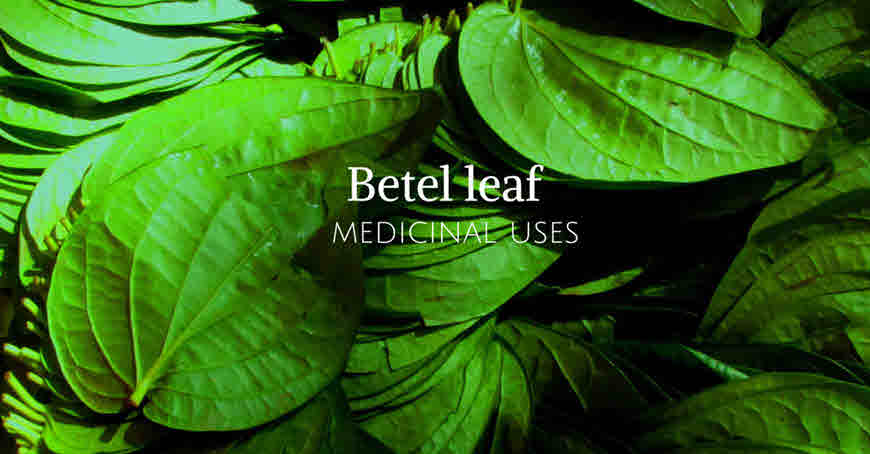The heart shaped leaves of Betel pepper are commonly known as Paan in India. It is eaten all over the country from time immemorial as Paan bida, which consists of betel nut, lime paste, spices and condiments wrapped inside the edible paan leaf. This is generally taken after meals to cleanse the palate and as mouth freshener.

Edible Paan leaf is obtained from plant betel vine. In Sanskrit, this plant is known by many names such as Tambool, Nagavalli, Nagvelleri, Nagani, etc. and its mention is found in various Ayurvedic classical texts such as Charaka Samhita, Sushruta Samhita and Astanga Hridayam. Ayurvedic texts mentions its medicinal properties and therapeutic uses. In Unani system of medicine, the leaves are used for blood purification, quenching excessive thirst, clearing the throat, improving appetite, taste and as tonic for the liver, heart and brain.
Scientific Classification
The botanical name of betel leaf is and Piper betle it belongs to the family piperaceae.
Piperaceae or pepper family, is large family of flowering plants distributed in tropical and subtropical regions. The plant belonging to this family are generally climbing herbs and shrubs. Piper is the only genus of this family which has economic importance. Some of the economic plants belonging to this genus are Black pepper, long pepper, Cubeb/Kabab chini, etc.
Betel leaf taxonomical classification is as given below:-
- KINGDOM: Plantae
- DIVISION: Magnoliphyta
- CLASS: Magnolipsida
- ORDER: Piperales
- FAMILY: Piperaceae
- GENUS: Piper
- SPECIES: betle
- BINOMIAL NAME: Piper betle L.
PLANT DESCIPTION
Evergreen, perennial, climber vine;stems 3mm in diameter, woody, dichotomous, articulate, swollen, rooted at nodes;4-2.5cm-long internodes;Leaves simple, spiral, and exstipulate;petiole 5mm long, channelled, and pubescent, blade 10cm x 6cm — 9.5cm x 5cm, ovate to ovate—oblong, and light green below;blade base cordate, apex acuminate;leaf secondary nerves in three pairs;inflorescence axillary spike 5.5cm long;fruits drupaceous, orange, and 3mm in diameter.
Propagation is by root division or cuttings, preferably taken in spring or summer.
Habitat:
Piper betel is native to central and eastern Malaysia. It is found in India, Indonesia, Malaysia, the Philippines, Sri Lanka, Vietnam, and China.
In India, it is cultivated in warmer and wet parts of India (Assam, West Bengal, Bihar, Uttar Pradesh, Karnataka, and Kerala).
Vernacular names
ENGLISH: Betel pepper AYURVEDIC: Tambula, Nagvallari, Nagini, Tambulvalli, Saptashira, Bhujangalata UNANI: Pan, Tambool SIDDHA: Vetrilai Nagavalli, Kammaruvetritai TAMIL: Vettilai TELUGU: Tamalapaku, Tamulapaku MARATHI: Pan, Nagvel, Vidyachepan KANNADA: Veelyade Ele Common Indian Name : Paan/Pan
Constituents Of Leaf: leaf contains Water (85-90%), Proteins (3-3.5%), Carbohydrates (0.5-6.1%), Minerals (2.3-3.3%), Fat (0.4-1%), Fibre (2.3%), Essential oil (0.08-0.2%), Tannin (0.1-1.3%), Alkaloid (arakene); Vitamin-C (0.005-0.01%), Nicotinic acid (0.63-0.89mg/100gms), Vitamin-A (1.9-2.9mg/100gms), Thiamine (10-70µg/100gms), Riboflavin (1.9-30µg/100gms);Calcium (0.2-0.5%), Iron (0.005-0.007), Iodine (3.4µg/100gms), Phosphorus (0.05-0.6%), Potassium (1.1-4.6%).
Traditional Medicinal uses
The roots, leaves, and fruits of Piper betle or Paan are carminative, stimulant, antiseptic and used for the treatment of malaria. Betel leaf has antiseptic, analgesic, antibacterial, anti-lactagogue (reducing breast milk), antioxidant, antispasmodic, cardiotonic, carminative, expectorant, litholytic, tonic and contraceptive properties.
Paan leaves contains an aromatic volatile oil. This essential oil has blood pressure lowering, cardiac as well as respiratory depressant and cardiotonic properties. It is powerful antiseptic due to the presence of phenol called chavicol. This oil is used as a counter irritant in swellings, bruises, and sores.
In Ayurveda, Paan leaves are considered Tikta/Bitter, Katu (pungent), kashaya/Astringent(Rasa/taste), Laghu/Light, Tikshna/Sharp, Sara, Vasada (Guna/Characteristics),
Ushna/Hot (Virya/Potency) and Katu/Pungent (Vipaka/Post Digestive Effect). The leaves are used in Ayurveda for weak digestion, fever, heart diseases, hoarseness of voice, etc. In Sushruta Samhita the leaves have been described as aromatic, sharp, hot, acrid and beneficial for voice, laxative, appetizer, beside this they pacify vata and aggravate pitta.
As the betel leaf is sharp, acrid and hot in nature so it should not be used in hyperacidity, bleeding disorders (rakta pitta), acidity, etc. Its oral intake is beneficial in diseases that occur due to vitiation of kapha dosha and harmful in diseases due to vitiation of Pitta dosha.
Betel leaf or Pan leaf is used both internally and externally. It is safe to use paan leaves for a few days and in recommended doses. Excessive internal use of leaves is harmful for health.
External uses:
- Wound healing: The leaves are applied externally to heal ulcers, boils, bruises, ulcerations of the nose.
- Eye injury/infection, night blindness: the leaves juice along with honey is applied as Anjan or used as eye drop.
- Headache: As the paan leaves are cooling and analgesic in action, therefore they are applied over the temporal regions for headaches.
- Inflamed joints: The leaves are also applied in case of joint and arthritis swelling.
- Respiratory ailments: In respiratory ailments, cold, cough, difficult breathing the leaves are soaked in mustard oil, warmed and applied to the chest.
- Throat irritation, hoarseness of voice: Gargling with pan leaves juice added in warm water gives relief in throat irritation.
Internal uses:
- Shleepad/Filaria: the paste of three paan leaves is taken with one gram rock salt with warm water, thrice daily.
- Stomach disorder: the leaves juice is taken orally.
- Throat irritation/swelling: The oral intake of leaves decreases cough and reduces swelling of throat.
- Dry cough: paan leaf juice is taken with honey.
- Impaired digestion, gas, bad breath: Chewing of Pan leaf is beneficial.
Dosage
For oral intake, Ayurvedic pharmacopeia of India recommends 10-20 ml juice of fresh leaves.
Excess use of betel leaf is harmful for health. Pregnant women have been advised not to use the essential oil of betel leaves.
Above given information is about the leaves of vine Piper betle. It is not about the betel leaf preparation or Pan Bida.
For whatever is said above are there any published or scientific findings? Because I find contradictions with some of the properties mentioned above with the information and research materials found. Thank you.